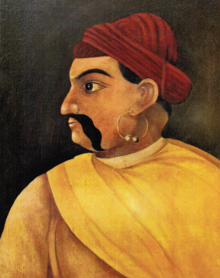|
Tukoji Rao Holkar
Tukoji Rao Holkar (26 June 1723 – 15 August 1797), belonging to the Holkar clan of the Marathas was the feudatory of Indore (r. 1795–1797). Tukoji Holkar was the adopted son of Malhar Rao Holkar, he was the second son of Shrimant Tanuji Holkar, a nephew of Malhar Rao Holkar. Thus he was also the grand-nephew of Malhar Rao Holkar.[citation needed] He married two wives. He had four sons Kashi Rao, Malhar Rao II Holkar, Yashwant Rao, and Vithoji Rao. Life and careerAfter the demise of Ahilyabai Holkar, Tukoji Rao was the only suitable person who could preserve the splendour of Holkar kingdom intact. He became the fourth ruler of the kingdom for a short period from 1795 to 1797 and protected the province as a courageous soldier. It was a time of crisis when Tukoji Rao received the responsibility of the Holkar Kingdom. Khanderao, husband of Ahilyabai had already lost his life in Kumbher war of 1754. Tukoji Rao Holkar was the most trustworthy commander-in-chief of Shreemant Malhar Rao Holkar. While on death bed, Malhar Rao's appreciation of Tukoji further intensified his loyalty to the royal house of Holkars. Malhar Rao said "You are the only one who can uphold my name and protect Prince Male Rao Holkar (grandson of Malhar Rao) after my death". But, Male Rao also had a very short-life span. He died on 13 March 1767 due to sickness. At this juncture, it was Tukoji Rao who has submitted himself to the service of Ahilyabai and she could withstand with the challenges she had in the service of her people of Malwa. Ahilyabai also respected him as her brother-in-law as Tukoji Rao was the adopted son of Malhar Rao Holkar I.[1] The remarkable and sincere services rendered by Tukoji Rao Holkar I during the reign of Malhar Rao Holkar I as a Commander in his army and during Ahilyabai Holkar as a Commander-in-Chief could congregate much recognition to his extraordinary talents in administration and as a chief of the armed forces. He, in the meantime, never forgot for a moment his original sense of obligation to the royal house of Holkars. He was more than obedient; he was dutiful, and all his actions were directed to please and conciliate the royal chair to which he was solely indebted for his high station. The people of Malwa felt themselves secure in the hands of Tukoji Rao Holkar I and the territories comprising the Holkar State continued to be prosperous for nearly two years after the death of Ahilya Bai. He actively participated in the conquests of Punjab and fought in the Battles of Lahore, Attock, and Peshawar in which he commanded many of the Maratha forces in the Punjab region and the frontier regions of Attock and Peshawar. He also conquered Jalalabad where he defeated Jahan Khan. Later after the debacle in Third Battle of Panipat, he played an important role Maratha Resurrection and subsequent First Anglo-Maratha War. Post that his relation with Mahadaji Scindia deteriorated.[2] Shah Alam spent six years in the Allahabad fort and after the capture of Delhi in 1771 by the Marathas, left for his capital in under their protection.[3] He was escorted to Delhi by Mahadaji Shinde and left Allahabad in May 1771. During their short stay, Marathas constructed two temples in the Allahabad city, one of them being the famous Alopi Devi Mandir. After reaching Delhi in January 1772 and realising the Maratha intent of territorial encroachment, however, Shah Alam ordered his general Najaf Khan to drive them out. In retaliation, Tukoji Rao Holkar and Visaji Krushna Biniwale attacked Delhi and defeated Mughal forces in 1772. The Marathas were granted an imperial sanad for Kora and Allahabad. They turned their attention to Oudh to gain these two territories. Shuja was however, unwilling to give them up and made appeals to the English and the Marathas did not fare well at the Battle of Ramghat.[4] The Maratha and British armies fought in Ram Ghat, but the sudden demise of the Peshwa and the civil war in Pune to choose the next Peshwa forced the Maratha to retreat.[5] Tukoji Rao died on 15 August 1797. He left behind him "the character of a good soldier, a plain, unaffected man and one whose courage was superior to his craft. The records show that during his lifetime he never used a seal of his own, and always been remained loyal to Malhar Rao and his family until his last breath."[citation needed] In popular culture
See alsoWikimedia Commons has media related to Tukoji Rao Holkar. References
|
||||||||||||||||||||||||||||||||||||
